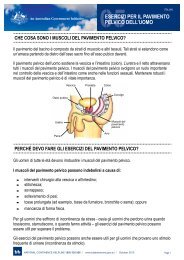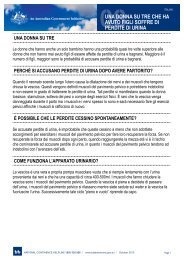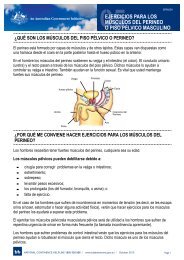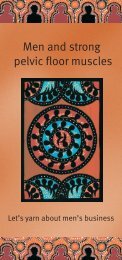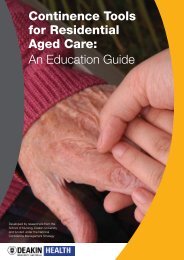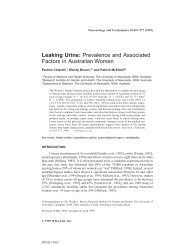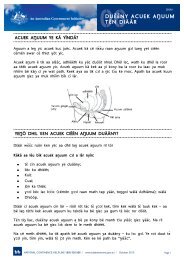Pharmacy Continence Care - Bladder and Bowel Website
Pharmacy Continence Care - Bladder and Bowel Website
Pharmacy Continence Care - Bladder and Bowel Website
You also want an ePaper? Increase the reach of your titles
YUMPU automatically turns print PDFs into web optimized ePapers that Google loves.
• Did not find incontinence clinic/professional advice helpful (only mentioned in baseline<br />
survey by 22 per cent).<br />
In the baseline survey only, consumers were asked how they felt when they spoke with the<br />
pharmacist or pharmacy shop assistant about incontinence. When speaking with a pharmacy<br />
shop assistant, 17 per cent of respondents (six people) felt embarrassed in some way (either<br />
a little: 11 per cent, quite: three per cent or very: three per cent embarrassed), while 54 per<br />
cent (19 people) did not feel embarrassed at all. This question was not applicable to 29 per<br />
cent (10 people). When speaking with a pharmacist, 16 per cent (five people) were<br />
embarrassed (either a little: 10 per cent or very: 6 per cent), compared with 52 per cent (16<br />
people) who were not embarrassed at all. This question was not applicable to 32 per cent<br />
(10 people).<br />
In the baseline survey only, respondents were asked whether they felt the pharmacy was a<br />
comfortable place to discuss needs. Eighty-six percent of respondents said yes, the<br />
pharmacy was a comfortable place to discuss needs, due to knowledgeable, helpful, caring<br />
<strong>and</strong> friendly staff, while the remaining 14 per cent felt it was not a comfortable place to<br />
discuss needs, due to lack of privacy.<br />
4.3.2 Case studies<br />
In light of the very limited sample of consumers, the project team invited participants in the<br />
follow-up survey group to consider participating in an in-depth interview with one of the<br />
project team. This invitation was accepted by 18 of the respondents to the CATI follow-up<br />
survey <strong>and</strong> subsequently the project team was able to interview three respondents to obtain<br />
qualitative information <strong>and</strong> data through a case study approach. The case studies indicate<br />
that the pro-active offer of assistance from pharmacy staff is regarded positively. These case<br />
studies amply illustrate the impacts of incontinence on the health <strong>and</strong> wellbeing of<br />
individuals, both those affected <strong>and</strong> those who provide care <strong>and</strong> support, <strong>and</strong> suggest that<br />
ease of access to community pharmacy information about continence <strong>and</strong> support <strong>and</strong>/or<br />
referral for individuals with incontinence may make a measurable difference to the capacity<br />
of the individual to cope with <strong>and</strong> better manage the impacts of incontinence.<br />
CONSUMER CASE STUDY 1<br />
Jane lives in a country town, <strong>and</strong> has had urinary incontinence problems since she<br />
was a child. Her severe asthma caused such strong coughing that she had a prolapse<br />
in her teens, leading to urinary incontinence. Things improved after surgery, but after<br />
the birth of her children pre-cancerous cells were found in her uterus <strong>and</strong> she had a<br />
hysterectomy, which was later followed by re-occurrence of urinary incontinence.<br />
Seven years ago she had a ‘repair’ which has improved her bladder to the extent that<br />
she can now walk downhill without leaking. Two years ago she started to develop<br />
bowel incontinence which she finds very difficult. Up till now, Jane has relied on a<br />
continence nurse who recently moved to another town <strong>and</strong> will not be replaced.<br />
She regularly buys her continence products from a pharmacy close to her. She says<br />
the pharmacist is very good, <strong>and</strong> must be aware of her continence problems because<br />
of her regular purchases. The pharmacist, however, has never actually discussed the<br />
problem with her, <strong>and</strong> she is not sure if she would be comfortable if he did. She is<br />
concerned about her privacy, because she lives in a small town. In any case, she<br />
says she doesn’t think there is anything he can do.<br />
The pharmacist does have information leaflets <strong>and</strong> a big poster about continence that<br />
promotes the <strong>Continence</strong> Helpline phone number. Jane rang the Helpline, <strong>and</strong> as a<br />
result of that went to see a local physiotherapist. The physiotherapist recommended<br />
that she have an internal examination. This was not an option that Jane could face at<br />
Final Report<br />
44<br />
NOVA Public Policy<br />
<strong>Pharmacy</strong> <strong>Continence</strong> <strong>Care</strong> Project



